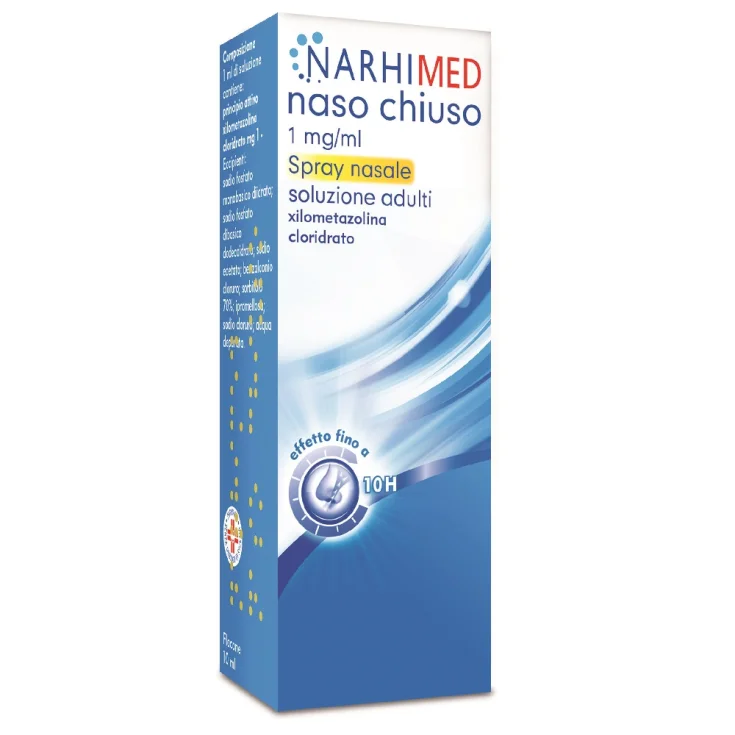Narhimed Adults 0.1% Nasal Spray 10ml

- Brand: HALEON ITALY Srl
- Product Code: 015598028
- EAN:
- Availability: In Stock (evaso in 24 ore)
- 3 items
for 6,70€ each - 4 items
for 6,57€ each - 5 items
for 6,43€ each
Narhimed Adults 0.1%
Nasal spray
Active principles
1 mg / ml nasal solution contains 1 mg / ml of xylometazoline hydrochloride. Each drop delivers 0.025 mg of xylometazoline hydrochloride. Each spray mist delivers 0.14 mg of xylometazoline hydrochloride. For the full list of excipients, see section 6.1.
Excipients
For all packs Monobasic sodium phosphate dihydrate; disodium phosphate dodecahydrate; sodium edetate; benzalkonium chloride; sorbitol 70%; hypromellose; sodium chloride; purified water.
Therapeutic indications
Decongestant of the nasal mucosa (in case of cold, hay fever or other allergic rhinitis, sinusitis). Otrivin is indicated in adults and adolescents over 12 years of age.
Contraindications
Hypersensitivity to xylometazoline or to any of the excipients. Chronic rhinitis. Pregnancy (see section 4.6). The drug is contraindicated in children under 12 years of age. Like other vasoconstrictors, do not use Otrivin in patients undergoing transphenoidal hypophysectomy or surgery with dura mater exposure. Patients with closed-angle glaucoma.
Dosage
Adults and adolescents over 12 years: instill in each nostril 2-3 drops of the solution, or 1 mist of Otrivin spray, 1-3 times a day, as needed. Pediatric population below 12 years: the product is only for adults and adolescents over 12 years and should not be used in children (see also section 4.3). Do not exceed 3 applications in each nostril per day. Method of administration Otrivin nasal drops 1) Clean the nose. 2) Recline your head back to a comfortable position or, if lying in bed, bow your head to the side. 3) Instill the drops into each nostril and keep the head tilted back for a while to allow the drops to spread into the nose. 4) Clean and dry the dropper immediately after use before putting it back in the bottle. 5) To avoid the possible spread of infection, the bottle should only be used by one person. Otrivin nasal spray The pre-dosed spray allows for precise dosing and ensures that the solution is well distributed on the surface of the nasal mucosa. Prevents the possibility of inadvertent overdose. Before using the spray for the first time, press the pump by triggering it a few times until a uniform mist is emitted. At subsequent applications, the dosing pump will be ready for immediate use. Be careful not to splash in the eyes. 1) Clean your nose. 2) Hold the bottle upright with your thumb under the base and the spout between your two fingers. 3) Lean forward slightly and insert the nozzle into one nostril. 4) Spray and simultaneously breathe gently through the nose. 5) Immediately after use, clean and dry the dispenser before replacing the cap. 6) To avoid the possible spread of infection, the spray should only be used by one person.
Warnings and Precautions
Otrivin, like other sympathomimetic agents, should be used with caution in patients who exhibit a strong reaction to adrenergic substances manifesting as signs of insomnia, dizziness, tremor, cardiac arrhythmia or elevated blood pressure. Like other topical vasoconstrictors, Otrivin should not be used for more than 7 consecutive days: prolonged or excessive use can cause rebound congestion. Benzalkonium chloride (BAC) contained as a preservative in Otrivin, especially when used for long periods, can cause swelling of the nasal mucosa. If such a reaction (persistent nasal congestion) is suspected, a nasal medicine without benzalkonium chloride should be used if possible. If such nasal medications without benzalkonium chloride are not available, another pharmaceutical form should be considered. It can cause bronchospasm. Do not exceed the indicated doses, especially in the elderly. Caution is recommended in patients with hypertension, cardiovascular disease, hyperthyroidism or diabetes mellitus, as well as in patients with prostatic hypertrophy. Otrivin should not be used in children under 12 years of age.
Interactions
As with all sympathomimetics, it cannot be excluded that the systemic effect of xylometazoline is reinforced by the concomitant use of monoamine oxidase inhibitors (MAOIs), tricyclic or tetracyclic antidepressants, especially in case of overdose.
Side effects
Adverse reactions are listed by organ system classification and frequency. Frequencies are defined as: very common (≥1 / 10); common (≥1 / 100 to <1/10); uncommon (≥1 / 1,000 to <1/100); rare (≥1 / 10,000 to <1 / 1,000) or very rare (<1 / 10,000). Within each frequency class, undesirable effects are reported in descending order of severity. Adverse reactions
Disorders of the immune system
Very rare: hypersensitivity reactions (angioedema, rash, pruritus)
Nervous system disorders
Common: headache
Eye disorders
Very rare: transient visual disturbances
Cardiac pathologies
Very rare: irregular heart rate and increased heart rate
Respiratory, thoracic and mediastinal disorders
Common: nasal dryness or discomfort
Gastrointestinal disorders
Common: Nausea
General disorders and administration site conditions
Common burning at the application site
Other side effects found: arterial hypertension, reflex bradycardia, urination disturbances, insomnia and restlessness.
Pregnancy and breastfeeding
Pregnancy In view of its potential systemic vasoconstrictive effect, it is advised to take the precaution not to use Otrivin during pregnancy. Breastfeeding There is no evidence of adverse effects on the breastfed infant. However, it is not known whether xylometazoline is excreted in human milk, therefore caution should be used and Otrivin should only be used during breastfeeding on medical advice. Fertility There are no adequate data on the effects of Otrivin on fertility and no animal studies are available. Since systemic exposure to xylometazoline hydrochloride is very low, effects on fertility are therefore very unlikely.






